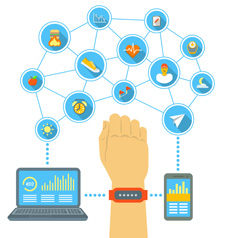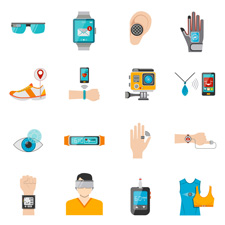
Using the 'Design Thinking' Method to Bridge the Digital Divide between Behavioral Scientist and their Institutional Review Boards
Camille Nebeker; John Harlow; Cinnamon Bloss; and Nadir Weibel
Vast quantities of personal health data (PHD) are increasingly being created through mobile apps, wearable sensors, and social networks, further expanding our ability to design and test personalized and adaptive health interventions1. While exciting, such studies are also raising new and nuanced ethical challenges that impact Institutional Review Boards (IRBs) and researchers alike2. Given the potential for improved individual wellness and decreased health care costs, ethical and regulatory concerns must be carefully considered. The Technology Special Interest Group believes behavioral scientists are important stakeholders in this conversation. We encourage our Society of Behavioral Medicine (SBM) colleagues to take a leadership role in influencing the responsible conduct of research studies that involve pervasive sensing and ubiquitous computing technologies.

Cloud Storage of Personal Health Data
Conversations about the ethical and regulatory aspects of research studies producing PHD are beginning to occur, albeit slowly and in silos. Those of us who are using new research tools and methods, which we are calling MISST for Mobile Imaging, pervasive Sensing, Social-media and location Tracking, are challenged to develop protocols for conducting this research in a manner that promotes informed consent and protects the confidentiality of the vast quantity and granular data produced by MISST technologies. MISST devices/apps can be worn, deployed, carried, or implanted to monitor and measure a research participant's behavior, location, and assorted biological indicators (e.g., sweat, heart rate). For example, we can now objectively measure sedentary behavior using a wearable accelerometer sensor 3,4, stimulate autobiographical memory via a wearable camera 5,6, monitor mental health with smartphone capabilities 7,8, mine social media to predict disease outbreaks 9,10, and track geographic location to contextualize health behaviors 4,11. These are fantastic opportunities, yet these new methods may be unfamiliar to the IRBs charged with reviewing related research. As researchers, we have a responsibility to develop protocols that are ethically sound and socially responsible. Likewise, we have a responsibility to educate our IRB members to assist them in identifying and managing study risks and risk management strategies. Over the past few years, we have observed a growing gap between the researchers who want to use MISST methods and the IRBs who review these protocols. This gap has led to unusually lengthy reviews and, at times, delayed approval of sponsored research.
To address this problem, the Robert Wood Johnson Foundation has granted support to develop the Connected and Open Research Ethics (CORE) initiative. The CORE initiative aims to bridge the growing gap between rapidly advancing technologies and a relatively static ethical landscape by creating responsive and dynamic standards informed by the CORE Network composed of IRB affiliates, researchers, tool makers, and, eventually, the public. We see SBM members taking an active role in CORE. As such, we put forth a call for action asking SBM members to join the CORE Network, contribute to the CORE Forum, and help grow the network by encouraging your colleagues and IRB to get involved. With active stakeholder engagement, the CORE initiative will provide the nearly 6,000 IRBs, and the thousands of researchers they represent, with dynamic best practices to guide the ethical design and review of MISST research studies.

Wearable Technology Devices
At the upcoming SBM 2016 Annual Meeting, our team will conduct a pre-conference seminar called CORE by Design. The goal is to generate ideas for the CORE functionality and development of processes that support SBM member needs (i.e., efficient IRB review, meaningful consent processes). The seminar format will use the Design Thinking (DT) approach to develop protocols designed to facilitate ethical research using MISST technologies. DT is an agile approach that enables groups to define problems, propose solutions, prioritize ideas, design a prototype, and plan an implementation strategy. During the seminar, participants will apply DT using the double diamond 4D approach where we initially Discover and Define then Develop and Deliver. As a formal method for practical and creative resolution of problems, DT emphasizes a phase during which the group focuses on generating as many ideas as possible using thoughtful prompts (e.g., how might we . . . increase motivation to self-track health behaviors underserved populations? create consent language that is accessible?). A goal of this seminar will be to engage SBM members as stakeholders to create ethical standards that support the changing landscape of 21st century science.
References
- Kumar, S. et al. Mobile Health Technology Evaluation. Am. J. Prev. Med. 45, 228-236 (2013).
- Nebeker, C., Orozco-Linares, R. & Crist, K. A Multi-Case Study Of Research Using Mobile Imaging, Sensing And Tracking Technologies To Objectively Measure Behavior: Ethical Issues And Insights To Guide Responsible Research Practice. J. Res. Adm. 46, 118-134 (2015).
- Rosenberger, M. E. et al. Estimating activity and sedentary behavior from an accelerometer on the hip or wrist. Med. Sci. Sports Exerc. 45, 964-975 (2013).
- Kerr, J. et al. The relationship between outdoor activity and health in older adults using GPS. Int.J.Environ.Res.Public Heal. 9, 4615-4625 (2012).
- Woodberry, E. et al. The use of a wearable camera improves autobiographical memory in patients with Alzheimer's disease. Memory 23, 340-9 (2015).
- Doherty, A. R. et al. Experiences of Aiding Autobiographical Memory Using the SenseCam. Human-Computer Interact. 27, 151-174 (2012).
- Torous, J. & Powell, A. C. Current research and trends in the use of smartphone applications for mood disorders. Internet Interv. 2, 169-173 (2015).
- Wang, R. et al. StudentLife: Assessing Mental Health , Academic Performance and Behavioral Trends of College Students using Smartphones. in UBICOMP '14, 3-14 (2014). doi:10.1145/2632048.2632054
- Christakis, N. a. & Fowler, J. H. Social network sensors for early detection of contagious outbreaks. PLoS One 5, 1-8 (2010).
- Chunara, R., Andrews, J. R. & Brownstein, J. S. Social and news media enable estimation of epidemiological patterns early in the 2010 Haitian cholera outbreak. Am. J. Trop. Med. Hyg. 86, 39-45 (2012).
- Jankowska, M. M., Schipperijn, J. & Kerr, J. A Framework for Using GPS Data in Physical Activity and Sedentary Behavior Studies. Exerc. Sport Sci. Rev. 43, 48-56 (2015).